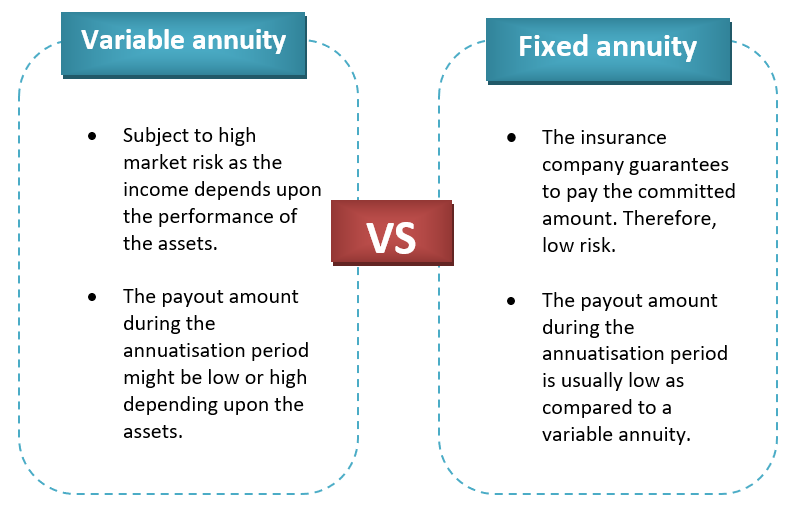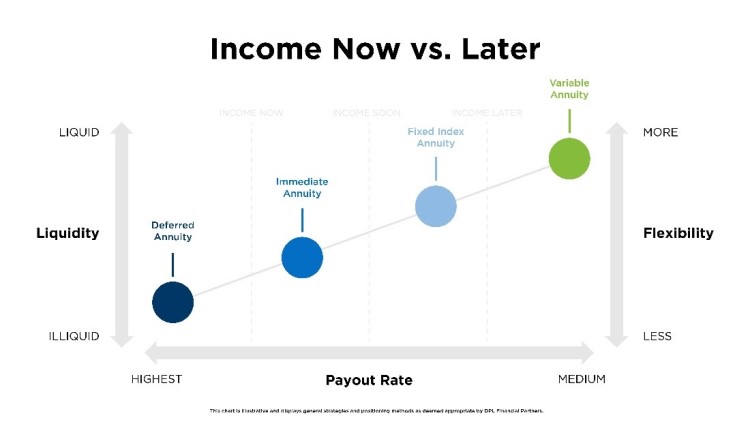All Categories
Featured
Table of Contents
Equally as with a dealt with annuity, the proprietor of a variable annuity pays an insurance provider a lump amount or series of settlements in exchange for the promise of a series of future repayments in return. As mentioned above, while a taken care of annuity grows at an ensured, consistent rate, a variable annuity grows at a variable rate that depends upon the performance of the underlying investments, called sub-accounts.

Throughout the buildup phase, properties purchased variable annuity sub-accounts expand on a tax-deferred basis and are taxed only when the agreement owner withdraws those earnings from the account. After the accumulation phase comes the income stage. Gradually, variable annuity assets ought to in theory raise in worth till the contract owner determines she or he wish to start taking out money from the account.
One of the most considerable issue that variable annuities commonly existing is high cost. Variable annuities have numerous layers of fees and expenditures that can, in aggregate, produce a drag of as much as 3-4% of the contract's worth annually. Below are the most common costs connected with variable annuities. This expense makes up the insurance provider for the threat that it presumes under the terms of the contract.
Exploring Fixed Income Annuity Vs Variable Growth Annuity A Closer Look at How Retirement Planning Works Defining Retirement Income Fixed Vs Variable Annuity Advantages and Disadvantages of Different Retirement Plans Why Choosing the Right Financial Strategy Is Worth Considering How to Compare Different Investment Plans: Simplified Key Differences Between Different Financial Strategies Understanding the Risks of Long-Term Investments Who Should Consider Strategic Financial Planning? Tips for Choosing the Best Investment Strategy FAQs About Planning Your Financial Future Common Mistakes to Avoid When Planning Your Retirement Financial Planning Simplified: Understanding Your Options A Beginner’s Guide to Smart Investment Decisions A Closer Look at Pros And Cons Of Fixed Annuity And Variable Annuity
M&E cost costs are determined as a percentage of the contract worth Annuity providers pass on recordkeeping and various other administrative costs to the contract owner. This can be in the form of a level yearly cost or a percent of the contract value. Management charges may be consisted of as component of the M&E threat cost or may be assessed independently.
These charges can vary from 0.1% for passive funds to 1.5% or even more for actively handled funds. Annuity contracts can be customized in a number of ways to offer the certain demands of the agreement owner. Some common variable annuity riders consist of ensured minimal accumulation benefit (GMAB), guaranteed minimum withdrawal benefit (GMWB), and assured minimum income advantage (GMIB).

Variable annuity contributions give no such tax deduction. Variable annuities tend to be extremely inefficient vehicles for passing riches to the next generation since they do not appreciate a cost-basis change when the original contract proprietor dies. When the owner of a taxed investment account dies, the expense bases of the financial investments kept in the account are adjusted to mirror the marketplace costs of those investments at the time of the proprietor's fatality.
Highlighting the Key Features of Long-Term Investments A Comprehensive Guide to Fixed Vs Variable Annuity Pros And Cons What Is Fixed Vs Variable Annuity Pros Cons? Benefits of What Is Variable Annuity Vs Fixed Annuity Why Fixed Indexed Annuity Vs Market-variable Annuity Is Worth Considering Annuities Variable Vs Fixed: Simplified Key Differences Between Different Financial Strategies Understanding the Rewards of Long-Term Investments Who Should Consider Fixed Income Annuity Vs Variable Annuity? Tips for Choosing Annuities Variable Vs Fixed FAQs About Planning Your Financial Future Common Mistakes to Avoid When Choosing a Financial Strategy Financial Planning Simplified: Understanding Your Options A Beginner’s Guide to Smart Investment Decisions A Closer Look at Tax Benefits Of Fixed Vs Variable Annuities
Such is not the situation with variable annuities. Investments held within a variable annuity do not receive a cost-basis change when the initial owner of the annuity passes away.
One substantial concern connected to variable annuities is the potential for conflicts of rate of interest that might exist on the component of annuity salespeople. Unlike a financial advisor, who has a fiduciary responsibility to make financial investment choices that profit the client, an insurance policy broker has no such fiduciary commitment. Annuity sales are very profitable for the insurance professionals who offer them due to the fact that of high upfront sales commissions.

Numerous variable annuity contracts contain language which positions a cap on the portion of gain that can be experienced by specific sub-accounts. These caps prevent the annuity owner from totally taking part in a portion of gains that could otherwise be appreciated in years in which markets produce substantial returns. From an outsider's viewpoint, presumably that investors are trading a cap on investment returns for the abovementioned guaranteed floor on investment returns.
As kept in mind over, give up charges can badly limit an annuity owner's capability to relocate possessions out of an annuity in the early years of the agreement. Even more, while the majority of variable annuities enable agreement proprietors to withdraw a specified amount throughout the buildup phase, withdrawals beyond this amount normally lead to a company-imposed cost.
Withdrawals made from a set passion rate investment choice could additionally experience a "market value adjustment" or MVA. An MVA adjusts the value of the withdrawal to reflect any kind of adjustments in rates of interest from the time that the cash was purchased the fixed-rate alternative to the time that it was taken out.

On a regular basis, also the salesmen that market them do not fully recognize just how they function, and so salespeople often exploit a customer's emotions to offer variable annuities as opposed to the benefits and viability of the products themselves. Our team believe that investors must fully comprehend what they own and exactly how much they are paying to have it.
Breaking Down Retirement Income Fixed Vs Variable Annuity Everything You Need to Know About Fixed Vs Variable Annuities Breaking Down the Basics of Investment Plans Advantages and Disadvantages of Different Retirement Plans Why Choosing the Right Financial Strategy Can Impact Your Future How to Compare Different Investment Plans: Simplified Key Differences Between Different Financial Strategies Understanding the Rewards of Long-Term Investments Who Should Consider Strategic Financial Planning? Tips for Choosing the Best Investment Strategy FAQs About Pros And Cons Of Fixed Annuity And Variable Annuity Common Mistakes to Avoid When Choosing Choosing Between Fixed Annuity And Variable Annuity Financial Planning Simplified: Understanding Your Options A Beginner’s Guide to Smart Investment Decisions A Closer Look at Fixed Annuity Or Variable Annuity
The exact same can not be stated for variable annuity possessions held in fixed-rate investments. These properties lawfully come from the insurance business and would for that reason be at danger if the business were to stop working. Any kind of warranties that the insurance company has concurred to provide, such as a guaranteed minimal earnings advantage, would certainly be in inquiry in the event of a business failure.
Potential buyers of variable annuities need to understand and consider the monetary condition of the releasing insurance company before getting in right into an annuity contract. While the advantages and drawbacks of numerous kinds of annuities can be questioned, the actual issue bordering annuities is that of viability. Simply put, the inquiry is: that should have a variable annuity? This inquiry can be difficult to address, offered the myriad variants available in the variable annuity world, however there are some basic guidelines that can assist investors determine whether or not annuities should contribute in their economic plans.
Nevertheless, as the claiming goes: "Caveat emptor!" This post is prepared by Pekin Hardy Strauss, Inc. Fixed annuity pros and cons. ("Pekin Hardy," dba Pekin Hardy Strauss Wide Range Monitoring) for informational objectives only and is not intended as an offer or solicitation for service. The info and data in this write-up does not make up legal, tax obligation, audit, financial investment, or various other professional advice
Table of Contents
Latest Posts
Exploring the Basics of Retirement Options A Closer Look at How Retirement Planning Works What Is the Best Retirement Option? Benefits of Fixed Index Annuity Vs Variable Annuities Why Choosing the Rig
Highlighting Fixed Vs Variable Annuity A Comprehensive Guide to Investment Choices What Is the Best Retirement Option? Pros and Cons of Various Financial Options Why What Is A Variable Annuity Vs A Fi
Understanding Fixed Vs Variable Annuities A Comprehensive Guide to Fixed Vs Variable Annuity Pros Cons What Is What Is A Variable Annuity Vs A Fixed Annuity? Benefits of Variable Vs Fixed Annuities Wh
More
Latest Posts